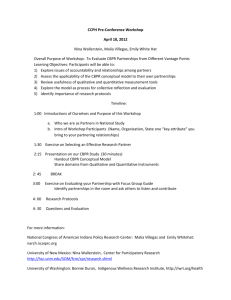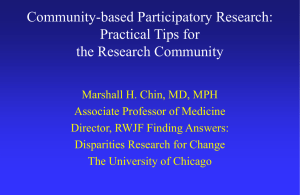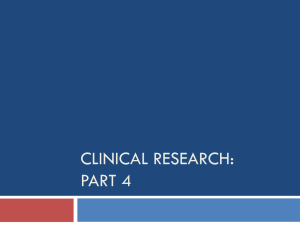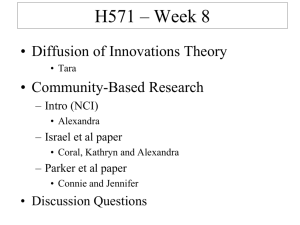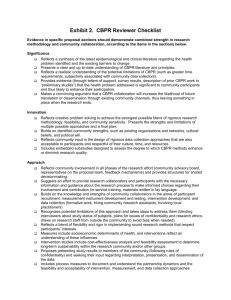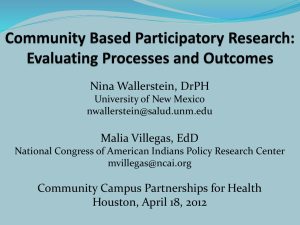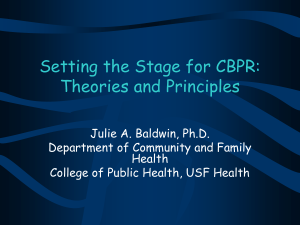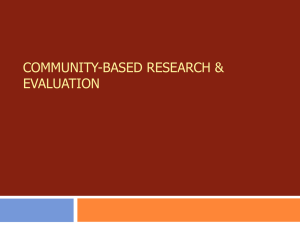A Review of Published Community-Based Participatory Research (CBPR) &
advertisement
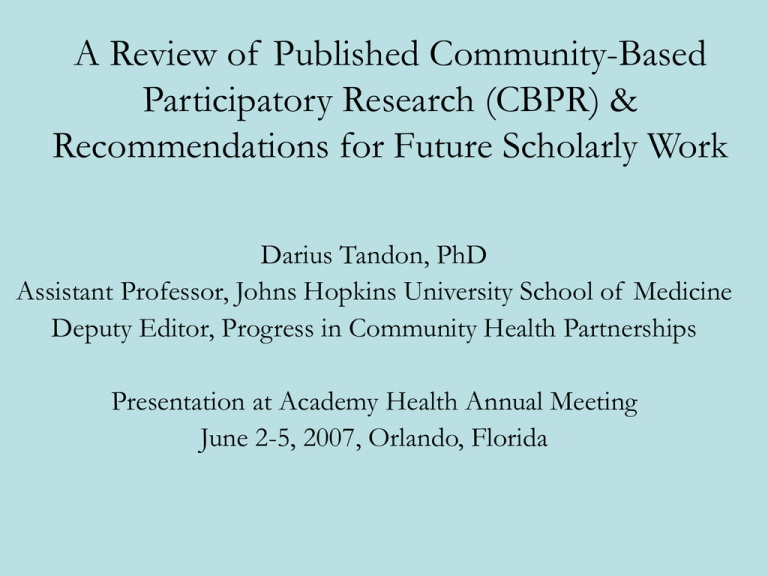
A Review of Published Community-Based Participatory Research (CBPR) & Recommendations for Future Scholarly Work Darius Tandon, PhD Assistant Professor, Johns Hopkins University School of Medicine Deputy Editor, Progress in Community Health Partnerships Presentation at Academy Health Annual Meeting June 2-5, 2007, Orlando, Florida Today’s Presentation 1. Definition, Characteristics, Rationale for CBPR 2. Review of Published CBPR 3. Priority Areas for Future CBPR Publications What is Community-Based Participatory Research (CBPR)? “A collaborative approach to research that equitably involves all partners in the research process and recognizes the unique strengths that each brings”. --W.K. Kellogg Foundation (2001) What CBPR is NOT 1. ”Community-placed” research 2. Sporadic or symbolic inclusion of communities 3. Basic research Key Characteristics of CBPR 1. 2. 3. 4. 5. 6. Active collaboration and participation from all partners at every stage of research Co-learning—i.e., community residents and researchers both contribute and learn from one another Projects are community-driven Results are disseminated in useful ways Research and intervention strategies are culturally appropriate Defines community as a unit of identity -O’Fallon & Dearry (2002) Why CBPR? Growing recognition that “traditional research”: 1. Has failed to solve complex health problems 2. Is not well suited for translational research 3. Does not adequately address locally identified needs A Vision for Progress in Community Health Partnerships (Tandon et al., 2007) • • Review of published CBPR in eight areas: 1. Original research 2. Work-in-progress/lessons learned 3. Theory and methods 4. Policy and practice 5. Education and training 6. Practical tools 7. Community perspective 8. Systematic reviews Recommendations for future CBPR publications Methods: Recommendations for Future CBPR Publications • Group judgment technique (i.e., Delphi Process) to elicit perspectives of leaders in the field of CBPR • Stage 1: Idea Generation – 17 Editors & Editorial Fellows of PCHP provided brief phrases on issues, problems, topics on which eight types of PCHP articles should focus • Stage 2: Idea Prioritization – Specific recommendations emerging from Stage 1 given to PCHP External Editorial Board to prioritize which thematic concepts they felt were most important for CBPR articles submitted to PCHP to address. Original Research Present Day • Intervention & nonintervention studies • Focused on an array of health issues • Many racial/ethnic groups with whom studies have been conducted Future Work • Translation of CBPR into policy • How do partnership characteristics and processes influence health outcomes? Work in Progress/Lessons Learned Present Day • Formative research to help design and modify interventions • Identify health problems on which a partnership should focus • Challenges & obstacles related to study design and implementation Future Work • Building community partnerships • Challenges in conducting CBPR Theory and Methods Present Day • Theoretical influences on CBPR (e.g., feminist theory, critical social theory, action research) • Theoretical frameworks for sustaining interventions; dealing with race, class, gender • Use of “non-traditional” research methods (e.g., photovoice, Delphi process) Future Work • Research methods • Use of theoretical and conceptual frameworks to guide CBPR projects • Research design issues Policy and Practice Present Day • Many examples of health domains in which CBPR has influenced policy (e.g., environmental health, smoking, violence prevention, occupational healthcare) Future Work • Engaging community members in policy and practice • How to implement policy/practice based on CBPR findings? Education and Training Future Work Present Day • CBPR curriculum and • IOM recommendation graduate medical that CBPR be taught to all education reform public health students • Training new investigators • Several master’s and • Training community doctoral level courses partners • www.cbprcurriculum.info Community Perspective Present Day • Little published work documenting community partners’ perspectives • Most published work that include community coauthors do not distinguish academic and community partners’ perspectives • Some exceptions: – Kelly et al. (2004) – Chene et al. (2006) Future Work • Community perspectives on research usefulness • Problems communities would like to see addressed by partnerships • Community perspectives on roles in CBPR projects Practical Tools Present Day • Two CBPR textbooks offer several practical tools (Minkler & Wallerstein, 2003; Isreal et al., 2005) • Instruments to determine whether project adheres to partnership principles • Tools to help develop and sustain partnerships Future Work • Resources/tools to develop community partners’ skills • Resources re: evaluation strategies Systematic Reviews Present Day • AHRQ Evidence Report on CBPR (Viswanathan et al., 2004): – Quality of methodology – Community involvement – Desired health outcomes Future Work • Reviews re: CBPR methods • Reviews re: CBPR effectiveness Closing Thoughts • Need for well-written peer-reviewed journal articles that describe various aspects of CBPR – Such articles can facilitate the pace and process of CBPR adoption among researchers and communities For More Information… Progress in Community Health Partnerships http://pchp.press.jhu.edu Darius Tandon standon@jhmi.edu Exercise 1. For your assigned topic, review the recommendations found in Table 2 2. In your opinion… – – Which recommendation is the highest priority? Is there a recommendation that should be on the list but is not? 3. Report back to larger group
